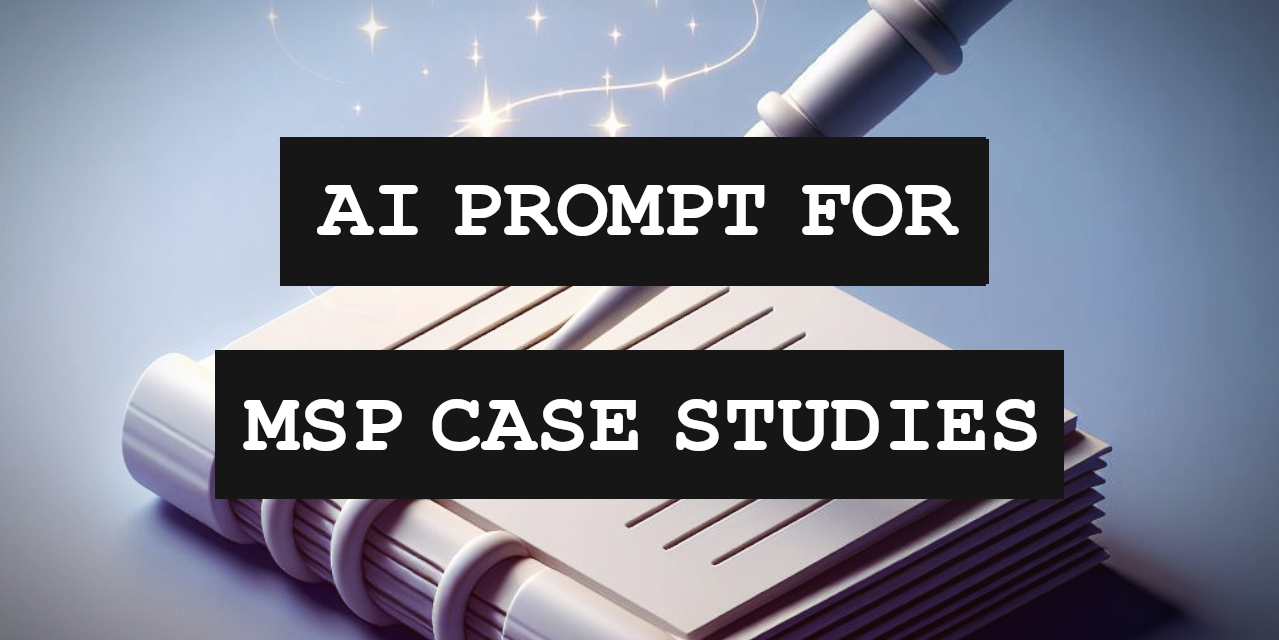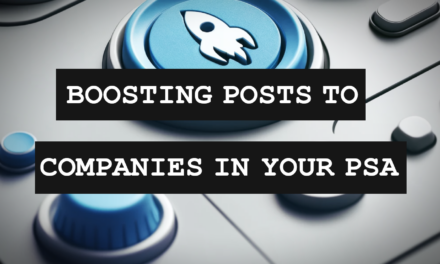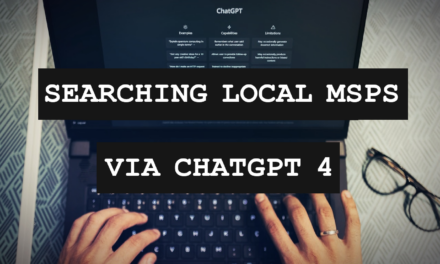Communicating Industry Experience
One of my favorite Authors and Marketers, Seth Godin, once said, “People do not buy goods and services. They buy relations, stories, and magic.” As much as I don’t want to believe it, this proves to be true in marketing time and time again. But what does this have to do with an industry case study? I believe that these three ingredients can lend themselves beautifully when putting together an asset to provide your prospects. I will explain:
Relations: People buy from people. A good industry case study should clearly explain the value of the relationship between an MSP and its customers in a given vertical. Most importantly, it should look and feel authentically “human” in the process.
Stories: The purpose of a case study is to tell a story that prospects can relate to. They should be able to see themselves in the subject of this story and want the outcome that is being achieved. This is why it is important to make it industry specific and distribute them accordingly.
Magic: This is that “it” factor that piques the prospects interest and makes your recipient curious to learn more. If your case study has this, you will be rewarded. The design process is usually where this magic comes from, which is why it’s important not to skimp out there.
When you put these ingredients together, you have something that proves to be useful with each and every encounter you have. Or as my fellow MSP Marketer, Paul Green says “ Not useful – essential. The whole point of marrying a vertical is that you can demonstrate you are THE expert at dealing with the technology aspects of their specific kind of business. The easiest way to do this is with case studies, because prospects see them as ‘reviews from other people like me.’ A CPA will be more influenced by what another CPA says about you, than what you say about yourself.”
With that being said, here is how you can leverage the power of AI to generate a high-impact industry case study with very minimal time and money invested:
The Ultimate Guide To Cash Flow For Managed Services
Sponsored by Alternative Payments & Zest
Formulating Your Case Study
Since case studies (like all stories) can be somewhat formulaic, I have found that a series of questions is the best starting point. This way you can be sure that you are hitting every important detail from beginning to end. To help with this process, we have created a questionnaire which you can use below.
If you are trying to work through the questions but experience writer’s block, try to just record yourself talking through the questions and answers and then transcribe your audio to text. Since all the content will be rewritten anyway, grammar does not matter, it just needs to be legible enough for the AI to understand.
Here is the questionnaire which you can use to begin documenting your IT project or customer experience:
Case Study Questionnaire
Industry Overview
- What is the name of the industry?
- Can you describe the primary services or products this industry provides?
- What are the typical challenges or pain points businesses in this industry face?
Client Information (Anonymized):
- What type of business within the industry did you support? (e.g., small business, mid-sized company, enterprise)
- What are the key characteristics of this client? (e.g., size, location, market scope)
Challenges and Requirements:
- What specific challenges did the client face that led them to seek your services?
- Were there any unique industry-specific requirements or compliance standards they needed to meet?
Solutions Provided:
- What specific services or solutions did you provide to address their challenges?
- How did you tailor these solutions to meet the industry-specific needs or requirements?
Implementation Process:
- Describe the implementation process, including any customization or integration with existing systems.
- How did you manage any challenges or obstacles that arose during implementation?
Results Achieved:
- What were the tangible results or improvements seen by the client after implementing your solutions? (e.g., increased efficiency, cost savings, improved security)
- Can you share any metrics or KPIs that highlight the success of the project?
Client Feedback:
- What was the client’s feedback regarding the outcome of the project?
- How has the solution impacted their business operations or competitive edge in their industry?
Lessons Learned and Best Practices:
- What were some key lessons learned from working within this industry?
- Can you identify any best practices that emerged from this project?
Conclusion and Future Outlook:
- How do you see your solutions evolving to continue supporting this industry?
- What future trends or technologies do you think will be important for this industry?
Additional Comments:
Is there anything else notable about this case study that hasn’t been covered?
The Ultimate Guide To Cash Flow For Managed Services
Sponsored by Alternative Payments & Zest
Developing Your Content
Now for the fun part! Once you have completed the questionnaire, it’s time to produce your content. This can be done using ChatGPT, Copilot, or really any AI based chat assistant that can handle large writing tasks. In addition to the completed questionnaire, you will also need to provide the AI chatbot with a “prompt” that explains what the output should be. We have created a very detailed prompt that you can customize and use below:
Case Study Generation AI Prompt
“Using the detailed information provided from my responses in the attached questionnaire, please draft a comprehensive industry specific case study for my IT company. The case study should be structured as follows:
Introduction: Briefly introduce the industry context and the client without revealing specific identities. Highlight the primary challenges the client faced.
Client’s Challenges and Objectives: Detail the specific challenges and objectives, emphasizing why these were particularly impactful for the client within their industry.
Solutions Provided: Describe the tailored solutions provided, including any customization and how they were specifically designed to address the client’s challenges and industry requirements.
Implementation Process: Outline the implementation process, including any notable obstacles encountered and how they were overcome. Highlight any collaboration with the client’s team.
Results and Benefits: Present the results and benefits experienced by the client post-implementation, supported by metrics or KPIs where available. Illustrate how these results solved the client’s initial challenges.
Client Testimonial (if available): Include a brief client testimonial that reflects their satisfaction with the solutions and outcomes.
Conclusion: Conclude with a summary of how the project demonstrates your expertise in supporting this industry. Mention any future plans or upcoming technologies that could further benefit the client or industry.
Call to Action: End with a call to action, encouraging readers to contact [company name] for similar solutions tailored to their industry-specific needs.
Please ensure the case study is engaging, professional, and accessible to readers unfamiliar with technical jargon. Use headings and bullet points to enhance readability. The final document should serve as a compelling showcase of our ability to address industry-specific challenges with highly customized solutions.”
After you have entered both the questionnaire and the prompt, you should receive a pretty solid rough draft in return. Keep in mind that you get out what you put in. If you answer the questions very briefly, you might not be that impressed with the response. You can also ask it for edits to make it longer or shorter based on the amount of content you are looking for.
The Ultimate Guide To Cash Flow For Managed Services
Sponsored by Alternative Payments & Zest
Outsourcing Your Design
Now for the “magic” which usually comes in the form of clever and bespoke presentations. No matter how valuable the written content might be, it needs that visual appeal to make it stand out. For this reason, I recommend working with a freelance designer to complete the rest of the project. A job such as this will likely range between $100-$250 for an experienced designer on Upwork or Fiverr, which is well worth the investment. I would look specifically for individuals with PowerPoint, Canva, or InDesign experience to complete this project.
Once you have located a designer to work with, you will need to provide them with a design brief so that they fully understand the deliverables for the project. Here is an example design brief that you can copy and customize to suit your needs:
Example Case Study Design Brief
Document Title: Enhancing Healthcare Operations through Tailored IT Solutions
Objective: Create a professional and visually engaging case study document that showcases our managed services project’s success in the healthcare industry. The document should be suitable for sharing with potential clients and on our website.
Design Specifications:
- Layout and Structure:
- Use a clean, modern layout that reflects the innovative nature of our solutions.
- Organize the content into clear sections with headings: Introduction, Client’s Challenges and Objectives, Solutions Provided, Implementation Process, Results and Benefits, Client Testimonial, Conclusion, and Call to Action.
- Color Scheme and Fonts:
- Incorporate our brand colors found on [our website] throughout the document to maintain brand identity.
- Choose fonts that are professional and easy to read, with headings that stand out.
- Visual Elements:
- Include relevant images and icons that complement the healthcare industry and the technological solutions provided. For example, imagery related to healthcare technology, cybersecurity, and cloud computing.
- Use charts or infographics to illustrate the results and benefits section, making the data easy to understand at a glance.
- Interactivity:
- If possible, incorporate interactive elements such as clickable links to our website in the Call to Action section.
- Format:
- Prepare the document in a PDF format for easy sharing and printing.
- Ensure the design is responsive for viewing on different devices if shared digitally.
Content Highlights:
- Emphasize the significant improvement metrics in the Results and Benefits section, such as the reduction in system downtime and increased patient handling capacity.
- Make the Client Testimonial stand out by using a large quote design or a highlight box.
Additional Notes:
- Please ensure there is enough white space around the content to make the document look uncluttered.
- The final design should convey professionalism and confidence, aligning with the high standards of our MSP services.
The Ultimate Guide To Cash Flow For Managed Services
Sponsored by Alternative Payments & Zest
Leveraging Your New Asset
Now that you have a shiny new piece of collateral at your disposal, you should look to use it in any way possible. Here are a few examples:
Website Lead Magnet – Feature the case study prominently on your website, either on the homepage as a success story or within a dedicated ‘Case Studies’ or ‘Success Stories’ section. Ask for an email opt-in to download.
Blog Articles – Break down the case study into a series of blog posts, each focusing on different aspects of the case study, such as the challenge, the solution, and the results. This approach can help drive traffic to your website and generate leads from the full document download.
Social Media – Share highlights or key outcomes from the case study on your social media channels. Use engaging infographics to summarize the case study and drive traffic to the full document available for download on your website.
Email Marketing – Include the case study in your email newsletters to current and potential clients of a similar industry. Highlighting your successes can keep your business top of mind and demonstrate your continued value.
Sales Presentations – Incorporate the case study into sales presentations and proposals to illustrate how you’ve successfully addressed similar challenges for other clients. This can also act as a “leave behind” for these meetings.
Direct Mailer – Creating a direct mail campaign centered around your case study can be a highly effective way to engage potential clients, especially when sent to prospects in a targeted industry.
Video Testimonials – If possible, create a video testimonial featuring the client discussing their experience working with your MSP. In the video, add a call to action to download the full case study document.
Conclusion
If you have just crushed a difficult IT project, or perfectly onboarded a new customer, then there is no better time than now to create a case study. While the process of documenting every detail can seem overwhelming at first, the power of AI takes a lot of leg work out of this process. If you do use this method to create your next industry case study, be sure to connect with me and share the results! I am excited to see what you come up with.

SPONSORED BY ZEST

















